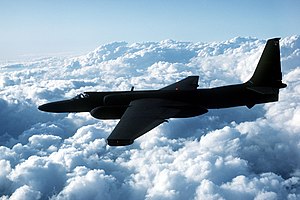Lockheed TR-1
| U-2 | |
|---|---|
 |
|
| A Lockheed U-2S in flight | |
| Role | High-altitude reconnaissance aircraft |
| National origin | United States |
| Manufacturer | Lockheed Skunk Works |
| Designer | Clarence "Kelly" Johnson |
| First flight | 1 August 1955 |
| Introduction | 1957 |
| Status | In service |
| Primary users |
United States Air Force Central Intelligence Agency (former) NASA Republic of China Air Force (former) |
| Produced | 1955–1989 |
| Number built | 104 |
The Lockheed U-2, nicknamed "Dragon Lady", is an American single-jet engine, ultra-high altitude reconnaissance aircraft operated by the United States Air Force (USAF) and previously flown by the Central Intelligence Agency (CIA). It provides day and night, high-altitude (70,000 feet; 21,336 m), all-weather intelligence gathering. The U-2 has also been used for electronic sensor research, satellite calibration, and communications purposes.
Early versions of the U-2 were involved in several events through the Cold War, being flown over the Soviet Union, China, Vietnam, and Cuba. In 1960, Gary Powers was shot down in a CIA U-2A over the Soviet Union by a surface-to-air missile (SAM). Another U-2, piloted by Major Rudolf Anderson, Jr., was lost in a similar fashion during the Cuban Missile Crisis of 1962.
The U-2 is one of a handful of aircraft types to have served the USAF for over 50 years. The newest models (TR-1, U-2R, U-2S) entered service in the 1980s. The current model, the U-2S, received its most recent technical upgrade in 2012. They have taken part in post–Cold War conflicts in Afghanistan and Iraq, and supported several multinational NATO operations.
After World War II, the U.S. military desired better strategic aerial reconnaissance to help determine Soviet capabilities and intentions. Into the 1950s, the best intelligence the American government had on facilities deep inside the Soviet Union were German Luftwaffe photographs taken during the war of territory west of the Ural Mountains, so overflights to take aerial photographs of the Soviet Union began. After 1950, Soviet air defenses aggressively attacked all aircraft near the country's borders—sometimes even those over Japanese airspace—and the existing reconnaissance aircraft, primarily bombers converted for reconnaissance duty such as the Boeing RB-47, were vulnerable to anti-aircraft artillery, missiles, and fighters. Richard Leghorn of the USAF suggested that an aircraft that could fly at 60,000 feet (18,300 m) should be safe from the MiG-17, the Soviet Union's best interceptor, which could barely reach 45,000 feet (13,700 m). He and others believed that Soviet radar, which used American equipment provided during the war, could not track aircraft above 65,000 feet (19,800 m).
...
Wikipedia
